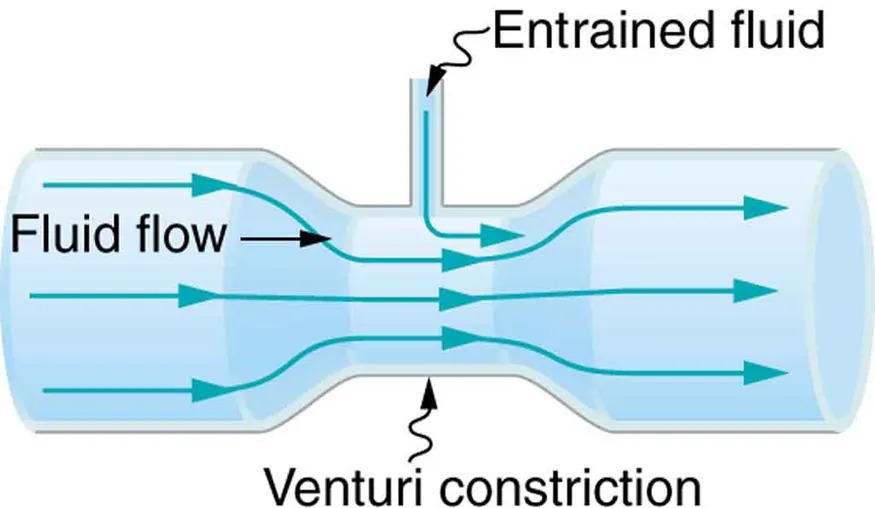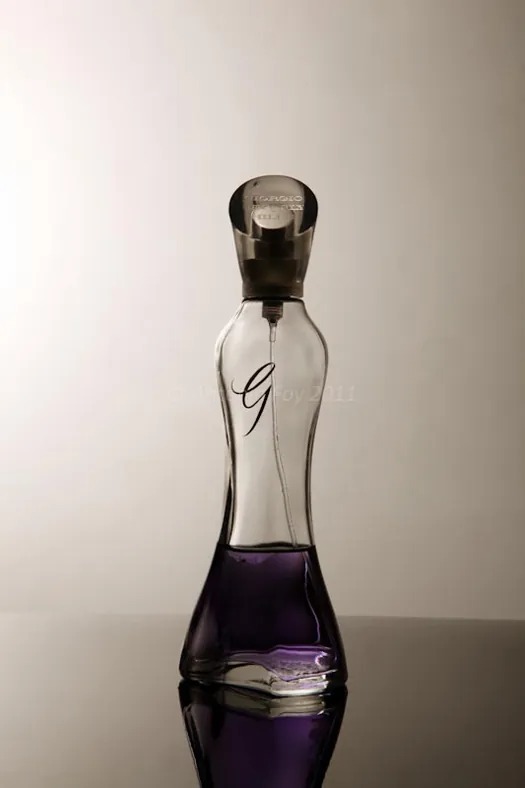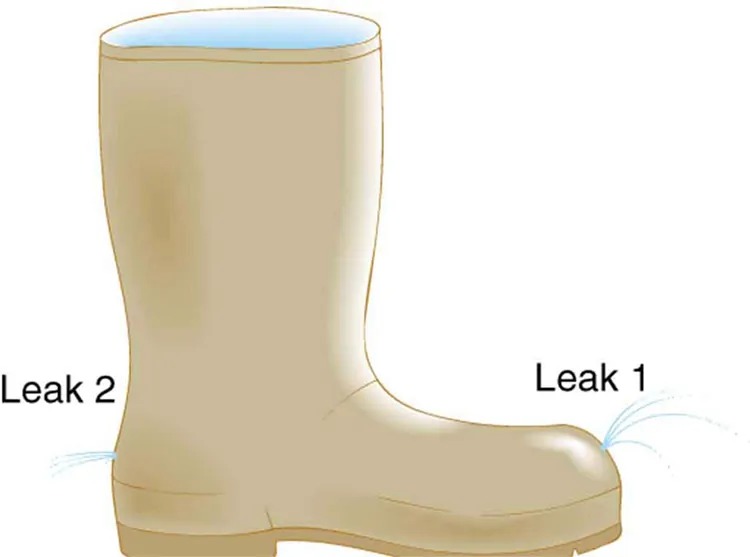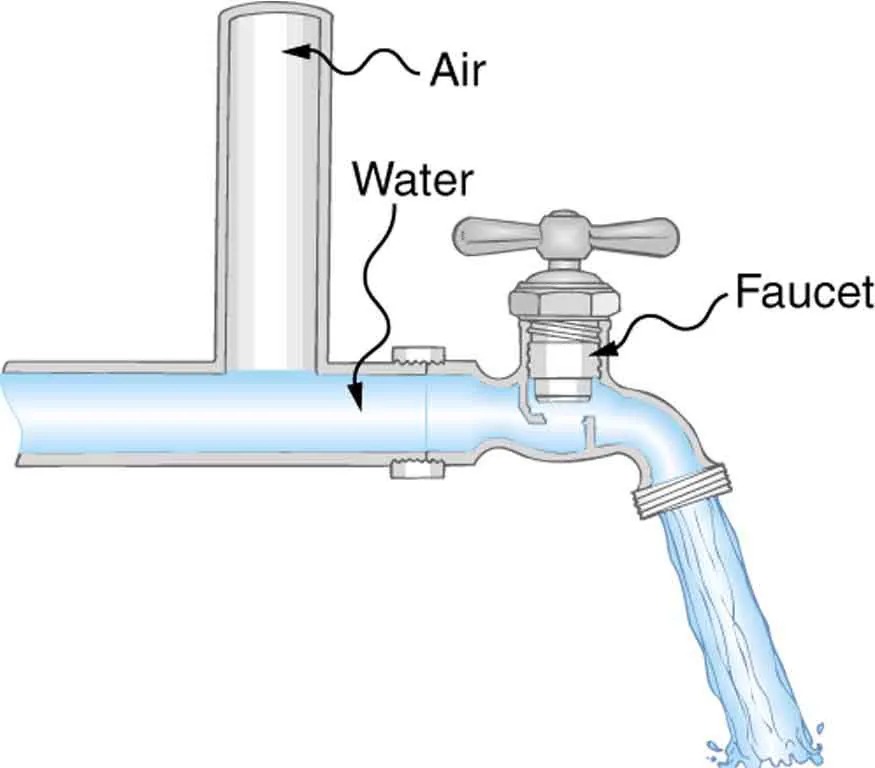Conceptual Questions
Conceptual Questions
10.1 Flow Rate and Its Relation to Velocity
- What is the difference between flow rate and fluid velocity? How are they related?
- Many figures in the text show streamlines. Explain why fluid velocity is greatest where streamlines are closest together. (Hint: Consider the relationship between fluid velocity and the cross-sectional area through which it flows.)
- Identify some substances that are incompressible and some that are not.
10.2 Bernoulli’s Equation
- You can squirt water a considerably greater distance by placing your thumb over the end of a garden hose and then releasing, than by leaving it completely uncovered. Explain how this works.
- Water is shot nearly vertically upward in a decorative fountain and the stream is observed to broaden as it rises. Conversely, a stream of water falling straight down from a faucet narrows. Explain why, and discuss whether surface tension enhances or reduces the effect in each case.
- Look back to Figure 10.4. Answer the following two questions. Why is [latex]P_{\text{o}}[/latex] less than atmospheric? Why is [latex]P_{\text{o}}[/latex] greater than [latex]P_{\text{i}}[/latex]?
- Give an example of entrainment not mentioned in the text.
- Many entrainment devices have a constriction, called a Venturi, such as shown in Figure 10.24. How does this bolster entrainment?

Figure 10.24 A tube with a narrow segment designed to enhance entrainment is called a Venturi. These are very commonly used in carburetors and aspirators. Image from OpenStax College Physics 2e, CC-BY 4.0
Image Description
The image contains a diagram illustrating the Venturi effect in a fluid flow system. It shows a horizontal tube that narrows in the middle, forming a Venturi constriction. Arrows within the tube indicate the direction of fluid flow from left to right. At the constriction, an upward vertical tube is connected, labeled as “Entrained fluid,” indicating where another fluid is drawn into the main flow. The narrowing part of the tube is labeled as “Venturi constriction,” highlighting the point where the fluid velocity increases and pressure decreases, causing the entrainment. The flow is represented with blue arrows, and the background of the tube is shaded in blue to represent the fluid.
- Some chimney pipes have a T-shape, with a crosspiece on top that helps draw up gases whenever there is even a slight breeze. Explain how this works in terms of Bernoulli’s principle.
- Is there a limit to the height to which an entrainment device can raise a fluid? Explain your answer.
- Why is it preferable for airplanes to take off into the wind rather than with the wind?
- Roofs are sometimes pushed off vertically during a tropical cyclone, and buildings sometimes explode outward when hit by a tornado. Use Bernoulli’s principle to explain these phenomena.
- Why does a sailboat need a keel?
- It is dangerous to stand close to railroad tracks when a rapidly moving commuter train passes. Explain why atmospheric pressure would push you toward the moving train.
- What assumptions are made in Bernoulli’s equation? Are these assumptions reasonably valid in the example of water flowing in a hose?
- A perfume bottle or atomizer sprays a fluid that is in the bottle. (Figure 10.25.) How does the fluid rise up in the vertical tube in the bottle?

Figure 10.25 Atomizer: perfume bottle with tube to carry perfume up through the bottle. Image from OpenStax College Physics 2e, CC-BY 4.0
- If you lower the window on a car while moving, an empty plastic bag can sometimes fly out the window. Why does this happen?
10.3 The Most General Applications of Bernoulli’s Equation
- Based on Bernoulli’s equation, what are three forms of energy in a fluid? (Note that these forms are conservative, unlike heat transfer and other dissipative forms not included in Bernoulli’s equation.)
- Water that has emerged from a hose into the atmosphere has a gauge pressure of zero. Why? When you put your hand in front of the emerging stream you feel a force, yet the water’s gauge pressure is zero. Explain where the force comes from in terms of energy.
- The old rubber boot shown in Figure 10.26 has two leaks. To what maximum height can the water squirt from Leak 1? How does the velocity of water emerging from Leak 2 differ from that of leak 1? Explain your responses in terms of energy.

Figure 10.26 Water emerges from two leaks in an old boot. Image from OpenStax College Physics 2e, CC-BY 4.0
Image Description
The image is an illustration of a single brown boot with clear water inside, nearly reaching the top. The boot has two labeled leaks where water is visibly spraying out. “Leak 1” is located near the front at the toe, with water spraying outward. “Leak 2” is towards the back, near the heel, also releasing a stream of water. The overall impression is that the boot is not watertight and is leaking at two points.
- Water pressure inside a hose nozzle can be less than atmospheric pressure due to the Bernoulli effect. Explain in terms of energy how the water can emerge from the nozzle against the opposing atmospheric pressure.
10.4 Viscosity and Laminar Flow; Poiseuille’s Law
- Explain why the viscosity of a liquid decreases with temperature—that is, how might increased temperature reduce the effects of cohesive forces in a liquid? Also explain why the viscosity of a gas increases with temperature—that is, how does increased gas temperature create more collisions between atoms and molecules?
- When paddling a canoe upstream, it is wisest to travel as near to the shore as possible. When canoeing downstream, it may be best to stay near the middle. Explain why.
- Why does flow decrease in your shower when someone flushes the toilet?
- Plumbing usually includes air-filled tubes near water faucets, as shown in Figure 10.27. Explain why they are needed and how they work.

Figure 10.27 The vertical tube near the water tap remains full of air and serves a useful purpose. Image from OpenStax College Physics 2e, CC-BY 4.0
Image Description
The image is a diagram illustrating the concept of a faucet connected to a pipe system. The diagram has labeled parts showing the water and air flow within the pipes:
– A vertical section of the pipe labeled “Air,” indicating the flow of air entering the system from above.
– A horizontal cross-section of the pipe, through which water flows, is featured. The water flow is labeled “Water.”
– A faucet is attached to the pipe, labeled “Faucet.” The faucet is open, allowing water to pour out.
The diagram displays the interaction between air and water within the plumbing system, illustrating water flow from the faucet when turned on.

